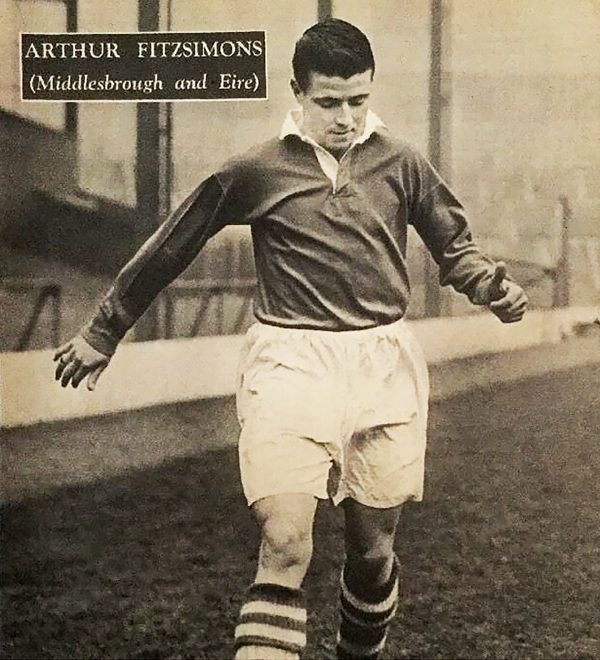
Pictured: Arthur Fitzsimons at his considerable best.
Arthur Fitzsimons was born in 1929 and lived in Penrose Street in Ringsend. He grew up to become perhaps the most exciting Irish footballer of his time.
He played schoolboy football for the famous local club, Johnville FC, and it was obvious that he was destined for a career as a professional footballer.
When he was 18 years old, Arthur signed for Shelbourne FC and during the 1948/49 season his searing pace, dazzling dribbling, precise passing and accurate shooting with left or right foot, marked him out as an excellent footballer.
He was transferred to the English Division One club, Middlesbrough in 1949. It took him some time to settle into English football, but he earned a regular place in the team at the start of the ‘51/’52 season, playing sixteen league games and scoring his first goal for Middlesbrough, away to Charlton Athletic in September 1951.
The next season he scored eleven goals and played thirty-five league matches. The goals he scored were important, and so were the chances he created for his teammates.
With his jinking runs, defence-splitting through-balls and teasing crosses, he was now a fine young player and an integral part of the Middlesbrough team.
One teammate who profited greatly from Arthur’s talent for making goals was Brian Clough who, after he broke into the Middlesbrough team, wasted no time telling Arthur what he wanted from him, saying “you make the bloody goals and I’ll score them.”
Arthur did just that, serving up chance after chance for Clough, who put them in the net time and again, becoming the most prolific goal-scorer in England. For ever after, he called Arthur the best goal-maker he ever played with.
Despite the talent in the Middlesbrough team, they were relegated from Division One in 1954. Arthur could have moved on but he stayed to fight for promotion from the second division. He spent his best years there, leaving at the end of the 1958/59 season. He played 231 games for Middlesbrough over his decade at the club, scoring 51 goals and creating many more.
Arthur made his Republic of Ireland debut in a World Cup qualifier against Finland in Dublin in October 1949. According to the Irish Times, he provided the “first thrill of the game when he beat three men in a brilliant solo effort, and cleverness was apparent in his every move,” as he helped Ireland win their first ever qualifying match.
In October 1952, Ireland played West Germany at Dalymount and Arthur was superb. In the first half, he pressurised a German defender into scoring an own goal, putting Ireland ahead, and soon afterwards he took a through pass in his stride, advanced into the penalty area, wrong-footed the German defence with a body swerve, then switched the ball onto his left foot, deceiving the keeper, and unleashed a vicious shot into the net for his first international goal.
Later on, he let fly from twenty yards with a rocketing strike that left the German keeper stranded as the ball crashed off the crossbar and straight back into play. In the end, his beautiful goal proved vital to Ireland’s nervy 3-2 win.
Thereafter, Arthur kept his place in the Ireland team and played some wonderfully effective football in the green shirt. His best run of form began when he scored Ireland’s only goal against Yugoslavia in October ‘55. A month later in Ireland’s next game, against Spain, Arthur made his mark early on when he burst through the left channel, exactly timing his move to meet a cross from the right, which he hit first time into the roof of the net, giving Ireland the lead. Spain equalised, then went ahead, and it seemed the game was surely lost, but Arthur kept making his forward raids, causing havoc as Ireland scored a last-minute equaliser.
Then, in May 1956 Ireland played Holland in Rotterdam and after a quiet first half, the teams were deadlocked at 1-1. According to the Irish Independent, Arthur “the boyish-faced streak of lightning lived up to his reputation as Ireland’s best continental footballer.” On 52 minutes, he took a through-pass from midfield and ran straight at the Dutch goal, tempting the ‘keeper forward, before gently moving the ball wide of him and into the net to put Ireland ahead. As attractive as that score had been, he outdid himself later, going on a sublime thirty-yard dribble through the entire Holland defence. He passed one, two, three Dutchmen as if they were statues then blasted in his second goal, making it 3-1 to Ireland. He had scored in three straight games for the Republic of Ireland, something no one else had done since the thirties.
Whether he was starting or finishing attacks, Ireland were a better side with Arthur playing, but they were never quite good enough and, like many great Irish footballers of the past, he never had the chance to play at a World Cup Finals.
On May 10, 1959, he played his last game for Ireland, away to Czechoslovakia. By that time, he was a Lincoln City player having transferred from Middlesbrough in March 1959. After just seven games with Lincoln, Arthur moved to Mansfield Town and played 62 matches for them between ‘59 and ‘61.
He was nearly 32 when he left Mansfield, his time in the Football League was over, but there was life in the legs yet. He played for three seasons with non-league Wisbech Town. In 1964, at the age of 35, Arthur left English football to play a couple of games for the Northern Ireland club, Crusaders. He joined Drogheda United in 1967, and then finally hung up his boots in 1969.
In 2009, Arthur was inducted into the Football Association of Ireland Hall of Fame, a well deserved honour indeed. And it is pleasant to be able to report that Arthur Fitzsimons, of Ringsend and Ireland, is still going strong at the age of 87. He is and will always be, Arthur the Great.
By Gavan Bergin



